The Royal Oak, Aspley Heath
Around 1824, one George Goodall enclosed about ¾ of an acre on the Heath, and a little later built himself a cottage there, which became no.20 Church Road, but he was astute enough to build his house on just one side of the frontage of the property. He was one of the ‘squatters’ of Aspley Heath, as he had no right to the land. After he had occupied it long enough, (and got others to swear oaths that he had held it, for perhaps years longer than he actually had!), it legally became his. Fortunately, a number of the deeds for this property are deposited at the Bedfordshire Archives under the Greene King archive collection.
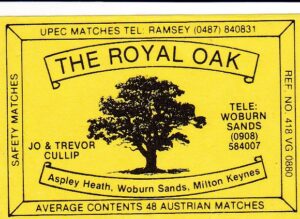
George had been ‘on the parish’ in his time, meaning he was supported with parish money as he didn’t earn enough to support his family. In 1827 he was given a week’s pay to assist him building his house, and later in the year, he was being paid 2/6 and 3/6 a week. On another occasion he was given a bit-saw, to help him in his work and keep him from drawing more funds from the parish.
After his death, his son John inherited the property and lived there with his widowed mother. After his marriage, in 1850 he built himself another cottage (no.18 Church Road) adjoining his late father’s. The cottage was a simple design of two living rooms, each about 12ft. by 11ft. with two corresponding bedrooms over, and resting on the back was a timber-built barn, 17ft. by 13ft., while 40 yards away up the garden was a boarded stable and the family closet. Other rooms have since been added on the lower side. The large barn and range of stabling has long since been pulled down. The water supply was from a well in the lower front corner of the garden.
To create a proper title to his property, and obtain £180 mortgage from the Woburn Benefit Building Society, in June 1853 John Goodall swore an affidavit that his father had built the property in about 1826, and had lived there till he died about 1839. His mother then lived in the house, until she died in 1851. Before she died, John had built his cottage next door, on the same land. He mentions there was a dispute about the ownership his father’s cottage after his father death, but that he has never paid rent to anyone for it. This was probably the Duke of Bedford trying to reclaim the land that was originally his. On the same day as his affidavit, Thomas Keens, bricklayer of Woburn Sands, also swore that he remembered George Goodall throwing up a bank around some land in 1824, and building a cottage two years later. Keens’ father had also erected a house nearby, by fencing off the Duke’s land and building a cottage. He recalled that, some years ago, there had been some dispute about the local cottages and one had been pulled down, but his and Goodall’s were left alone.
Three years later, Goodall bought land behind his cottage from Gabriel Ireland for £12. Gabriel needed to state he had had undisturbed occupation of the premises for 30-plus years. Goodall gave the cottage his father had built to his sister, who was married to John Sollom. Sollom, like the Goodall’s, was a sawyer by trade.
Goodall owned most of the land now occupied by St. Michael’s churchyard, and had four acres fronting the top of Church Road, which was later the hockey ground of the Knoll School. He also had land in Aspley Guise, and became a timber merchant with a yard near Woburn Sands Station. The money the parish had spent on a simple saw for his father George was money well spent!
Goodall took a further mortgage from George Woods of Oakley, a keeper for The Duke of Bedford, for £120 in 1860. I would be surprised if the Duke was involved in lending money to the people who had fenced off his land and effectively stolen it, unless perhaps he thought the squatters would default on their loans and he would be able to reclaim the land.
Goodall took another mortgage for £400 on New Year’s Day 1862, from Elizabeth Platt of Bedford. This much larger amount was secured on all Goodall’s property and land on Aspley Heath. It looks like he was able to pay this off by 1866, but a year later he re-mortgages again, to John Thomas Green, a Woburn solicitor, for £1000. Crucially, this included the right for Green to sell on the properties. £1000 is a large amount of money for 1867, but Goodall went back for further loans for more than £2500. Was this to start his timber yard at Woburn Sands Station?
All this financial borrowing and mortgaging obviously attracted some adverse comments locally as a noticed appeared in the Northants Mercury in February 1864:
“I, Henry Turney of Husborne Crawley, in Bedfordshire, hereby acknowledge that the statements and accusations made by me in January last reflecting on the credit and solvency of John Goodall, of Woburn Sands, in Buckinghamshire, Timber Dealer, were untrue and without any foundation whatsoever and I express my sorrow and apologize for having made such statements and accusations. Dated 11th Day Feb. 1864”
John Goodall remained in his cottage until about 1868-69, when he sold it, along with the other pieces of land he had acquired, to John Green, the Woburn lawyer. It was apparently Green who obtained the first beer licence. John Goodall never appears as a licensee, and the deeds show it was only licenced after he sold it. (He did, however, later become owner of The Station Hotel). Arthur Parker, the late village historian, believed Goodall may have been running an unofficial beer trade from the cottage as a side line. The trade probably arose from the demands of the sandpit, woodsmen and Fullers earth workers, returning down the hill from work, tired and thirsty.
The first public record of the new beerhouse comes from the Bucks Herald. It reported on 19th November 1870, that the license of The Royal Oak, Aspley Heath had changed from Jesse Smith to William Hill. (In the same paragraph it reported that another unnamed beerhouse on Aspley Heath also transferred their licence, and this must have been The Flying Duck on Heath Lane.)
It shows how long news took to travel, as the change of license was not reported in the Northants Mercury until 4th February 1871. That year, the census also took place. Although there is no specific entry in Aspley Heath mentioning the Royal Oak, William Hill is there, listed as a Pianoforte Tuner, with his wife, two sons and a daughter, and a visiting dressmaker also staying at the house. Hill stayed until May 1872, when he was replaced by John Goodhall, according to the Beds Times.
An attempt was made to sell the beerhouse the next year. This advert appears in the Luton Times and Advertiser of 6th July 1872:
“…Also that brick built and slated freehold public house and premises situate at Woburn Sands and known by the sign of the Royal Oak. To be sold by Auction by W. H. Derbyshire at the Swan Inn, Woburn Sands, on Thursday the 11th of July 1872 at five o’clock precisely by the direction of the proprietor..”
[In the same sale is mentioned The Rose and Crown, at Woburn Sands, which I have not been able to pinpoint.]
By the time of the Licensing Return in 1876, John Green is still the owner, so the sale above did not go though, as many auctions didn’t, but the inn had by now been let to William Pritzler Newland, the Bedford brewer, who had installed William Ingle as licensee. On 30th September 1876, the inn passed out of local hands and into the world of big breweries, as Green sold the beerhouse outright to Newland, then in partnership with F. T. Young. At the same time, Green also sold them The Dukes Head in Aspley Guise. In the transfer, the Royal Oak is described as:
“Messuage, Tenement or beerhouse called ‘Royal Oak’, Woburn Sands, Aspley Guise, with garden, stable, skittle shed and outbuildings …now in the occupation of Ingle.”
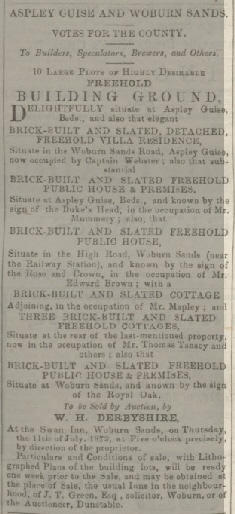
Newland wasn’t above borrowing on the inn either. In 1877 he secured £1200 on the Royal Oak and The Dukes Head, Aspley Guise, from Edward Rose, a Bedford draper, and then over £13,000 from Charles Powell of Newport Pagnell, against a large number of the breweries properties, notwithstanding the mortgage already on the Royal Oak and Dukes Head.
At the next census in 1881, Ingle was still there, with his wife Rebeckha. He was 70 and she 71. There were also six lodgers and travellers in the house. It must have been a tight squeeze!
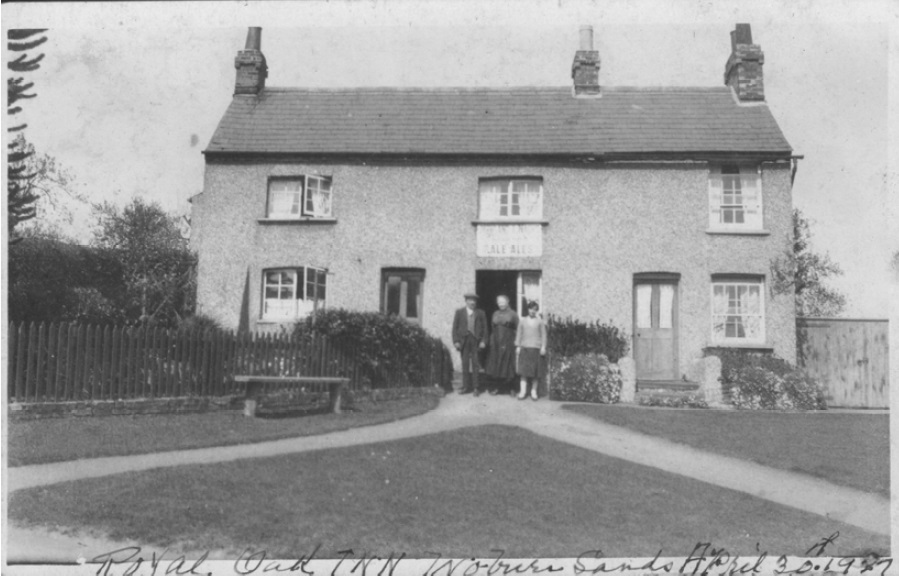
An edition of the Northants Mercury in November 1889 reported that the licence was transferred to a John Clarke, but it does not record who from.
At the 1891 census, Frederick Brawn was landlord, with no lodgers in the house, but I doubt they had room, as they had seven children themselves. Frederick helped make ends meet by also working as a gardener. He was originally from Northamptonshire, and most of his children were born in Yardley Gobion, Cosgrove and Grendon.
When owners William Pritzler Newland sat up a new Limited Company in 1897, (Newland & Nash) his brewery in Lurke Street, Bedford and 59 freehold pubs, six under copy hold and 15 leaseholds were also transferred. Locally, this included the freeholds of The Duke’s Head in Aspley Guise, The Wheatsheaf in Wavendon and The Royal Oak in Aspley Heath, with cottage adjoining including skittle shed (tenant now John Wilson), as well as the lease of The Weathercock, Woburn Sands, and just over 2 acres of land beside it (Gravel Pit Close) This had been leased from Sir Henry Hoare in 1895, and the landlord was Frederick Roberts. This coincided with their looking for a new tenant for The Oak. From the Beds Times, 21st February, 1891:
“ROYAL OAK BEER HOUSE, at Woburn Sands, TO BE LET, with early possession. Large Garden. Apply, Newland & Nash, Lurke Street Brewery, Bedford.”
In November 1894, there is a news report of a quarrel between Frank Elmer and Richard Seal, described as a Beerhouse keeper of Aspley Heath, over some rabbits. Elmer and Seal were thrown out of the Fir Tree Inn, with Joseph Griffen being given a black-eye in the process and Seal offered to fight Elmer for £5, but Elmer refused. Both men were convicted, with Seal receiving a larger fine as he was a beerhouse keeper who should have known better! We know he was the Royal Oak licensee, as the following Luton Times and Advertiser report from 1st April 1898 confirms:
“The Owner Found – The pony and cart which was found straying on the highway by the lamplighter one day last week has now been claimed by Mr Seal of Newport Pagnell, who at one time was the landlord of the Royal Oak, Aspley Heath. How the animal could possibly have strayed so great a distance unobserved is a mystery.”
In 1901, the landlord was Joseph Wilson (61), with his wife Sarah (63). They were from Wellington in Salop, and had one daughter, Alice (22) with them. The 1903 Licensing Return stated that the house was clean and in fairly good repair, but it still only had a beer licence. The Wilsons stayed from 1897 to 1910.
A year before the 1911 Census, the Wilson left to be replaced by John Cowell. He and his wife Mary had five children, one of whom left Woburn Sands for a new life in Canada in March 1911. They still managed to squeeze one lodger in, Thomas Clarke. Cowell was also a stationary engine driver, possibly getting both agricultural work and at the local fullers earth works, although the main local mining firm had folded in 1900.
The Royal Oak remained with Newland & Nash, who were taken over by Wells & Winch of Biggleswade in 1924. Cowell was still landlord in 1927, when the inn was valued under the terms of the Rating Valuation Act of 1925. Every piece of land and property was inspected to determine the rates to be paid on it. At that time the Royal Oak consisted of a tap room, kitchen, private living room and scullery downstairs, with a cellar beneath. The inn must have been extended by this time, as by now upstairs there were five bedrooms and outside a washhouse and WC and coal barn. Trade consisted of about three barrels of beer and three dozen bottles of minerals per week. Rent was £12 per annum. The valuer noted: “a lovely little green patch in front”, and that the tenant “Keeps house very clean & I think some personality here”.
The Cowells stayed until 1933, their replacement being his own son-in law, Percy Radley. From the Bedfordshire Times and Independent, 12th May, 1933:
“WOBURN SANDS Mr. John Cowell, who for the past twenty three years has been landlord of the “The Royal Oak”, Aspley Heath, is retiring this week. He has been a resident in the district for about thirty years, and as landlord he has always been much esteemed by his patrons and friends. The “Royal Oak” is a picturesque place, well known for its frontage of beautiful turf, which Mr. Cowell has always kept in good condition by mowing about three times week. Mr. and Mrs. Cowell are retiring to live in a house in the newly-developed Downham Road, and are to be succeeded at the Royal Oak by Mr. and Mrs. P. Radley, their son-in-law and daughter.”
Radley stayed 16 years until 1949, when Alexander Carlile took over. His licence application was still only to sell “beer, wine, cider & perry”, with no spirits, but he soon moved on to run The Swan, in Woburn Sands in 1953 and William Harris took the pub. Wells & Winch of Biggleswade were taken over by Greene King in 1961.
It is not known how long Harris was there, but by 1959 it had changed to Frank & Ann Alston. The pub had never been modernised and retained the old public house layout of a bar area to drink in, with pints being brought in from out the back by the landlord when asked for, then the following appeared in the Woburn Reporter on January 19th, 1965:
“Walk into the historic Royal Oak public house, Aspley Heath, and you will find a 100-year-old pub has undergone a remarkable transformation – a twelve-month modernisation scheme has just been completed. When 55-year-old Lancashire-born landlord Mr. Frank Alston, father of three grown-up children, came to the village five years ago he made up his mind to make his first pub a regular “home from home”. He had no bar and he and his wife, Anne, had to carry drinks from an outside room to serve customers in the primitive tap room.
There were only wooden benches to sit on but Mr. Alston worked hard towards his goal of a building a homely reputation for his house. It was not easy work. Apart from serving his customers at night, he had a window cleaning round to do by day. But now, impressed by the way he has attracted new people to the pub, the brewery has spent thousands of pounds giving the house a new face. The Royal Oak can now boast a long, streamlined bar. The old-fashioned tap room has been converted into a comfortable parlour with attractive pew-type seats replacing the primitive wooden benches of the past.
A few feet away, a saloon is tucked cosily into an alcove within arm stretching reach of the communal bar. New lighting, flooring and a change of décor have all been included in the transformation. “Everybody seems to like the change and it makes it a lot easier for me,” said Mr Alston last week. “I was formerly a steward in a Lancashire drill hall. This is much better and we have made friends. Now I’m hoping a car park will be provided shortly for my customers.” Set in an acre of land, the Royal Oak, which was originally three cottages before its public house days, is living up to its name. The new look takes away none of the country house character, but adds prestige where it is well deserved.”
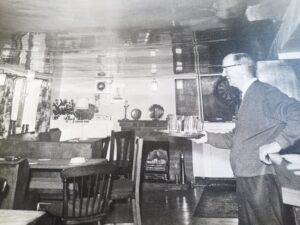
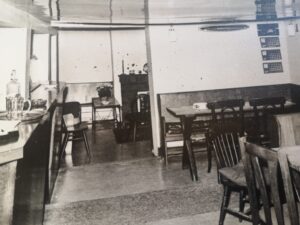
The Alston’s served for 18 years, before Trevor Cullip and Steve Fursby covered the next 12 years between them. It was taken by Mick Ryan, who eventually left after 31 years in 2020, the longest serving Royal Oak landlord to date. After he moved on, it was significantly remodelled with a number out outside seating pods being added to the frontage.
Landlords
????-1870 Jesse Smith
1870-1872 William Hill
1872-???? John Goodhall
1876-1881 William Ingle (Licensing Return & Census)
1885-???? W J Cooper (Parker research)
1891-???? Frederick Brawn (Census)
1897-1910 Joseph Wilson, beer retailer (Kellys Directory)
1910-1933 John Mole Cowell *
1933-1949 Percy Radley *
1949-1953 Alexander Stewart Carlile *
1953-???? William Melville Harris *
1959-1977 Frank & Ann Alston
1977-1985 Trevor Cullip
1985-1989 Steve Fursby
1989- 2020 Mick Ryan
* Information from Bedfordshire Archives.
Page last updated Apr 2023.
